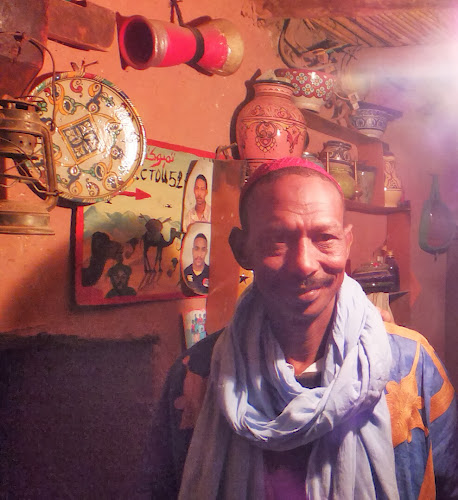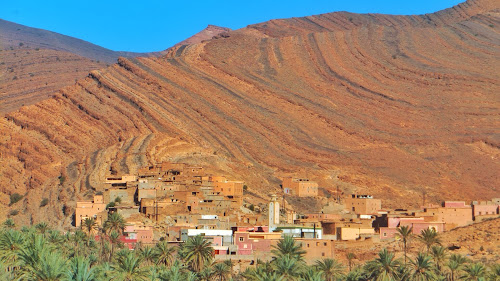We didn't initially set out to see the desert.
We somehow just managed to arrive - the benefit of not thinking too long or too hard about the potential dangers. We set out from Ouarzazate for the Drâa on a whim and were richly rewarded.
There are lots of über-serious Europeans around dressed like the Leyland Brothers, all sporting gigantic four wheel drives which are stacked with supplies, big plastic containers of water sensibly secured under tarps on their roof racks. We've rented another put-put-put local car, brought along a bottle of mineral water for sustenance.
We arrived at Tamnougalt where the valley begins. There are soaring mud brick towers, pock marked, pisé walls, a fabulous sunken kasbah with the caïd's palace at its centre. The palace is comprised of elegant courtyards supported by graceful arches and includes a harem with intricate wooden grilles for the ladies to hide (be hidden?) behind. There are also former gardens with beautiful Andalusian niches from the 16th century; these gardens once supported orange trees, roses and other flora.
We scrabbled over the rubble in the old mellah and recognise the Star of David over an archway, the synagogue has almost totally caved in. The dark, mud brick village hardened and cracked by centuries of baking hot sun is bounded by palmeries on all sides.
We drive for several hours more along the valley...
To tell the truth, the Sahara proper is 80 or so kilometres further down the road. The asphalt is crumbling and the road is quickly turning into what looks like a perilous, sandy track.
We know what awaits us in M'Hamid - a carnival of camel rides, environmentally unfriendly safari tours, photo opportunities with desert tribesmen and the like.
We decide to leave the desert fun to our well-stocked, European counterparts and make our way back to Tamegroute where we hope to see the 16th century Sufi library of Zouia Nacrii.
The library has thousands of manuscripts and was once one of the richest in North Africa. A collection of manuscripts is still on display among them a 14th century Quran with exquisite Kufic script, writings of Avicenna (Ibn Sina), Ibn Rushd (Averroes) and an Arabic translation of Pythagoras!
There are treatises on theology, astronomy, geography and pharmacology as well.
Tamegroute is also famous for its "subterranean kasbah" - a whole residential quarter whose streets and houses are built in rabbit warren fashion to protect against the scorching sun which beats down mercilessly for most of the year.
We make our way into the dark labyrinthine kasbah. We immediately get lost in the network of disorientating alleyways. A friendly man who tells us he lives there approaches us. He invites us into his split level, adobe home which you enter through a port-hole styled door and are taken up several flights of stairs into a snug living area and kitchen.
We are served mint tea and talk about his family. Ahmed is fifty. His wife, whom he describes as his "gazelle" (or was it "güzel" as in the Turkish for "darling") later appears on the scene when we are making our way out. He married late in life he tells us and has a daughter in grade one.
Most of the residents he says are "Haratin", the descendants of African slaves brought into Morocco mainly from Mauritania, Mali and the Sudan, along the caravan routes.
Entering the Drâa Valley you immediately notice how many of the folk are of black African descent. European style dress, especially amongst the women, diminishes. It suddenly occurs to you that this is Africa even though the French you speak and the physical proximity of Morocco to Europe suggests otherwise.
I always shy away from photographing people and never ask. Ahmed, however, sees I have a camera bulging in my pocket and invites me to take a few pictures. It occurs to me that we are not the first tourists to be invited in for tea or the first to be invited to take a few snaps. It doesn't matter. We just go with it.
Afterwards we are guided by Ahmed to the souk and later to the zouia. We pay him well for the great afternoon he has made for us.
I was concerned coming to Morocco that our engagement with people would be totally dominated by the what I heard was very aggressive hard-sell on the part of the locals. Perhaps it is that we haven't seen the worst of it yet - we have not been near Marrakech. My impression of Moroccans, however, is generally quite the contrary to what I feared. They are kind and humble.
And so we make our way out of the kasbah with Ahmed's assistance. Another fabulous day in Morocco.


















































